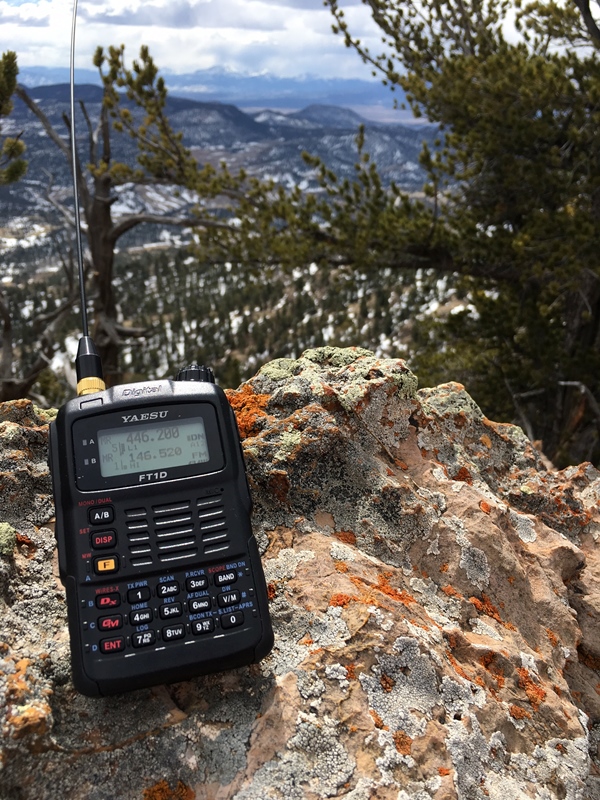Author Archive
 How About an Updated FT-817?
How About an Updated FT-817?
The Elecraft KX2 made a big splash with QRP enthusiasts at the Dayton Hamvention this year. HamRadio360 had some good coverage of the product introduction. Basically, the KX2 is a shrunken version of the KX3, covering the HF bands 80m through 10m.
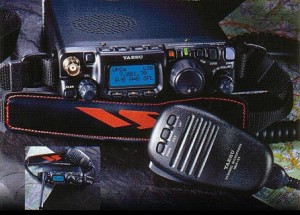
There were rumors circulating that Yaesu would introduce a replacement for the FT-817ND, but that turned out to not be true. It is a good rumor because the original FT-817 was introduced way back in 2001 (according to Wikipedia). Also, Chris Wilson NØCSW was actively soliciting inputs for an 817 replacement at the Central States VHF Conference last summer.
A while back, I did a comparison of the FT-817 and the KX3 (big brother to the KX2). I evaluated the two radios from a VHF/UHF point of view. The FT-817 is the only portable single-radio solution for 50 MHz, 144 MHz and 432 MHz. The KX3 includes 50 MHz standard and 144 MHz is an option. The KX2 leaves out the VHF bands completely to achieve a smaller size.
What’s Next for the FT-817?
Its always fun to speculate on what might be coming in new gear. I expect Yaesu will maintain its position as the QRP transceiver that covers HF/VHF/UHF. It has a long history of delivering cost-effective “do everything” radios. We can look to recent product introductions from Yaesu to get a hint of what might be coming.
The FT-2DR, FT-400DR and FT-991 have all adopted larger touch-screen displays so we can probably expect that for the 817 replacement. However, this will challenge the existing form factor…you can’t just drop a larger display into the existing 817 design. The three newer radios include the System Fusion C4FM digital mode…at this point, I don’t think Yaesu would introduce a VHF/UHF radio without it.
Which raises another question: will the new radio also include a GPS receiver? This capability is a good complement to the C4FM mode in a portable radio. The FT-991 requires you to enter your location manually, which the FT-2DR and FT-400DR use a built-in GPS. But it adds circuitry and complexity so I am going to guess they will leave that out.
I am expecting (hoping?) Yaesu will improve the battery life of the transceiver. (Receive standby current is spec’d at 450 mA.) Even if they don’t improve the current drain, newer battery technology could be used to improve operating time. Also, depending on the form factor changes, it may be wise to dedicate more space for a physically larger battery.
Yaesu will probably improve the overall receiver performance, including advanced DSP features. Many 817 users have complained about the lack of coverage of 162 MHz weather radio in the US. On the transmit side, a little more output power would be nice…maybe match the KX3’s 10 watts on HF. Yaesu could really make the VHF crowd happy (in the US) if they included the 222 MHz band.
Take One Tablet
The radio will surely have a computer I/O port with USB being the most flexible choice. There is an opportunity to innovate a bit here by coupling the radio with Android and iOS tablets. I could see a really nice app that handles logging, CW, PSK31, RTTY, bandscope, and other advanced features. This could take the pressure off having a larger display and loading tons of features into the radio. The most convenient I/O would be wireless, most likely Bluetooth or maybe WiFi. Many of the SOTA and QRP operators already take along a smartphone or tablet for logging and other tasks, so it would be a good fit to that market. The key to this idea is careful human factors design and tight integration with the radio. Do I expect this from Yaesu? Not really. So surprise me and knock my socks off.
Those are my thoughts. Your turn.
73, Bob KØNR
The post How About an Updated FT-817? appeared first on The KØNR Radio Site.
 This Spewed Out of the Internet #32
This Spewed Out of the Internet #32
 It has been a while since I’ve done one of these Internet Spewing posts, so I’ve got some catching up to do.
It has been a while since I’ve done one of these Internet Spewing posts, so I’ve got some catching up to do.
Twitter is heating up with rumors and reports of new ham gear to be introduced at the Dayton Hamvention. Elecraft is introducing the KX2 QRP HF transceiver. I know this one is real because Steve WGØAT got a chance to try out a unit, shown here in this video. Also, see the short review by Frank KØJQZ.
VA3XPR broke the news about a VHF/UHF radio that does DMR, D-STAR and C4FM digital modes. This is exciting stuff but we’ve been here before and nothing materialized. It is definitely achievable…someone just has to do the work.
K3NG comments on the most recent innovation from Heathkit, the Pipetenna. Leixen recently introduced a 25 W UHF handheld radio. Now who thinks THAT is a good idea?
The FCC is thinking about making amateur radio licenses last for a lifetime. See the KB6NU blog and comments on the topic.
The ARRL announced that the August UHF Contest is cancelled, thereby ticking off the hams that like to work that contest. It seems they also ticked off the many hams that have been contemplating participating in the contest for the last decade but just haven’t gotten around to it yet.
Not cancelled but expanded is the Colorado 14er Event, which will go the whole weekend (August 6-7). Check out the ham14er web site for the latest info. Its our 25th year and its going to be fun!
The Atlantic published a decent article on ham radio, focusing on the emergency communication aspect of the radio service. Yay!
Don’t forget to participate in the National Pizza Ovens On The Air (NPOOTA) event. Unfortunately, there’s been some partisan bickering about Obama’s recent activation. In related news, here’s a proposal to abolish the use of Q codes. To which I say, QSL!
After one of our Tech Licensees asked “just how many antennas do I need to cover all these bands?”, I wrote this article at HamRadioSchool.com: Antennas… How Many Do I Need?
Another important question is How Many Digits of Pi Do I Need? It turns out that JPL has figured this out using actual math and the answer is 16 digits. You don’t need anymore than that. Ever.
OK, that’s it for now. No, I am not going to be at Dayton. All of the Cool Kids went to Hamcon Colorado instead.
73, Bob KØNR
The post This Spewed Out of the Internet #32 appeared first on The KØNR Radio Site.
 Summits On The Air – Colorado Style
Summits On The Air – Colorado Style
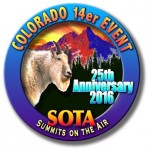 Summits On The Air – Colorado Style is the title of my presentation at Hamcon Colorado, 2 pm Friday May 13th. I will be discussing the Summits On The Air program and the Colorado 14er Event.
Summits On The Air – Colorado Style is the title of my presentation at Hamcon Colorado, 2 pm Friday May 13th. I will be discussing the Summits On The Air program and the Colorado 14er Event.
The slides are available here:
Summits On The Air -Colorado Style
The conference will be excellent. I hope to see you there!
73, Bob KØNR
The post Summits On The Air – Colorado Style appeared first on The KØNR Radio Site.
 Announcing: 25th Annual Colorado 14er Event
Announcing: 25th Annual Colorado 14er Event
 Amateur Radio operators from around Colorado will be climbing many of Colorado’s 14,000-foot mountains and Summits On The Air (SOTA) peaks to set up amateur radio stations in an effort to communicate with other radio amateurs across the state and around the world. Join in on the fun during the 25th annual event and see how many of the mountaintop stations you can contact. This year the event is expanded to include the entire weekend. However, many mountaintop activators will hit the trail early with the goal of being off the summits by noon due to lightning safety concerns.
Amateur Radio operators from around Colorado will be climbing many of Colorado’s 14,000-foot mountains and Summits On The Air (SOTA) peaks to set up amateur radio stations in an effort to communicate with other radio amateurs across the state and around the world. Join in on the fun during the 25th annual event and see how many of the mountaintop stations you can contact. This year the event is expanded to include the entire weekend. However, many mountaintop activators will hit the trail early with the goal of being off the summits by noon due to lightning safety concerns.
See the very cool 25 Year Anniversary t-shirts available at http://www.cafepress.com/wg0at
The 14er event includes Summits On the Air (SOTA) peaks, which add over 1700 potential summits! If you aren’t up to climbing a 14er, there are many other summits to choose from (with a wide range of difficulty). See the W0C SOTA web page at w0c-sota.org
Radio operators who plan to activate a summit should post their intent on the ham14er Yahoo Group. To subscribe to the “ham14er” email list, visit the Yahoo groups site at http://groups.yahoo.com/group/ham14er/ . Also, be sure to check out the event information at http://www.ham14er.org It is also a great idea to post an ALERT on the SOTAwatch.org website.
Frequencies used during the event
Activity can occur on any amateur band including HF and VHF. The 2m fm band plan uses a “primary frequency and move up” approach. The 2m fm primary frequency is 147.42 MHz. At the beginning of the event, operators should try calling on 147.42 MHz. As activity increases on that frequency, move on up the band using the 30 kHz steps. Don’t just hang out on 147.42 MHz…move up! The next standard simplex frequency up from 147.42 MHz is 147.45 MHz, followed by 147.48 and 147.51 MHz.
| Frequency (MHz) | Comments | Frequency (MHz) | Comments |
| 147.42 | Primary 2m FM Frequency, then up in 30 kHz steps | 14.060 | 20m CW Frequency |
| 147.45, 147.48, 147.51 | Alternate 2m FM frequencies | 14.345 | 20m SSB Frequency |
| 446.000 | Primary 70 cm FM frequency | 18.092 | 17m CW Frequency |
| 446.025 | Alternate 70 cm FM frequency | 18.158 | 17m SSB Frequency |
| 144.200 | 2m SSB calling frequency | 21.060 | 15m CW Frequency |
| 50.125 | 6m SSB calling frequency | 21.330 | 15m SSB Frequency |
| Other Bands/Modes | Standard calling frequencies and/or band plans apply. | 28.060 | 10m CW Frequency |
| 28.350 | 10m SSB Frequency |
Warning: Climbing mountains is inherently a dangerous activity.
Do not attempt this without proper training, equipment and preparation.
Sponsored by The Colorado 14er Event Task Force
Here’s the event flyer in pdf format: Colorado 14er Event Flyer 2016
The post Announcing: 25th Annual Colorado 14er Event appeared first on The KØNR Radio Site.
 DX, Artificial Scarcity and The List
DX, Artificial Scarcity and The List
 Economists see scarcity, supply and demand as fundamental forces in a market. Items that are scarce demand a higher price while items that are easy to obtain tend to have a lower price. A diamond is an example of something that is relatively scarce (and in demand) so it commands a high price. In contrast, wood is generally available and is much less expensive than diamonds.
Economists see scarcity, supply and demand as fundamental forces in a market. Items that are scarce demand a higher price while items that are easy to obtain tend to have a lower price. A diamond is an example of something that is relatively scarce (and in demand) so it commands a high price. In contrast, wood is generally available and is much less expensive than diamonds.
Then there’s the concept of artificial scarcity. If some items can be made scarce (or even just appear scarce), the price will tend to increase. For example, if I own all of the banana trees on an isolated island, I could reduce the available supply of bananas and command a higher price from all of the banana eaters there. Or maybe I start screening bananas for quality and I put a special sticker on them to brand them as special.
 We have a case of artificial scarcity in ham radio, called the DXCC list. This list defines what is considered a separate country when chasing DX. (Actually, the correct term is entity, not country.) For example, Hawaii (KH6) and Alaska (KL7) are considered separate entities even though they are part of the United States. (See Is Alaska a Country?) For someone chasing DXCC entities, because Alaska is on The List, a radio contact with Alaska becomes more desirable. It’s kind of like putting a “premium sticker” on a banana to indicate that it is special.
We have a case of artificial scarcity in ham radio, called the DXCC list. This list defines what is considered a separate country when chasing DX. (Actually, the correct term is entity, not country.) For example, Hawaii (KH6) and Alaska (KL7) are considered separate entities even though they are part of the United States. (See Is Alaska a Country?) For someone chasing DXCC entities, because Alaska is on The List, a radio contact with Alaska becomes more desirable. It’s kind of like putting a “premium sticker” on a banana to indicate that it is special.
In my imagination, the DXCC list resulted from a bunch of hams sitting around drinking beer and bragging about how many countries they had worked. One guy, Larry says he just worked Hawaii, bringing his total to 125 countries. His buddy Leroy says, “You can’t count Hawaii because it’s part of the US of A.” To which Larry says, “You bet I can count Hawaii…and Texas too. It’s a whole ‘nuther country.” Clearly, we are going to need an official list to keep track of what counts as a country. A more credible version of how the list got established is captured in this article from the October 1935 QST.
Of course, the two main factors that drive scarcity of DXCC entities is the ham radio population and ease of access. Radio contacts are easy to make with entities that have an active ham population. If an entity doesn’t have many active hams but is easy to get to, someone will probably put that location on the air once in a while. On the other hand, some locations are unpopulated and really difficult to get to. These are not only on The List, they are on The Most Wanted List.
Kingman Reef (KH5) was just deleted from The List, instantly changing it from one of the most desired contacts in amateur radio to a big giant Why Bother. You see, there used to be 340 countries on the list but now there’s only 339. Kingman Reef will now be considered part of Palmyra/Jarvis, so it still has value for DXCC, just a lot less.
As I write this article, there is a major DXpedition (VKØEK) operating from Heard Island, an unpopulated island near Antartica. The only reason those guys are there is that Heard Island is on The List. Take a look at their web site and you’ll see how much time and energy has gone into activating this lonely island. Drop it from the list and suddenly a radio contact with this location is a lot less in demand.
So try to keep this all in perspective. There are lots of radio contacts out there to be made, some more interesting and desirable than others. It is appropriate and necessary that we have the DXCC list, to provide consistency in how we count countries, I mean entities. But really, it all traces back to Larry and Leroy arguing about who worked the most countries.
Thanks to the dedicated DXpeditioners that put these rare locations on the air.
73, Bob K0NR
The post DX, Artificial Scarcity and The List appeared first on The KØNR Radio Site.
 Yaesu FT-1DR: A Trail Friendly SOTA HT
Yaesu FT-1DR: A Trail Friendly SOTA HT
A common topic in the QRP community is the Trail Friendly Radio (TFR) concept for backpack-style operating on the high-frequency bands. I’ve adapted the concept for the VHF/UHF bands, calling it the VHF Trail Friendly Radio (VTFR).
Strong candidates for the best VTFR include the Elecraft KX3 (with 2m option) and the Yaesu FT-817. Heck, both of these radios deliver all of the HF bands, 6m and 2m in one portable package. (The FT-817 also has 70cm.) See my blog post that compares the two rigs.
But the other set of strong contenders for the best VTFR is one of the many dualband HTs available on the market. It is hard to beat the compact, portable attributes of these great little radios for casual use on the trail. I’m not going to review them all but instead talk about my current favorite: the Yaesu FT-1DR. (Yaesu has recently replaced the FT-1DR with the newer model FT1XDR, which is the same design but with an improved GPS receiver and larger battery pack.)
My main usage of the radio is when hiking and doing Summits On The Air (SOTA) activations. This radio has a lot to offer in terms of capability and features, but the main things that stand out are 2m/70cm band coverage, two independent receivers and built-in GPS/APRS capability. Most SOTA VHF operating is on 2m fm so that band is critical, but I also make contacts on 70cm. More important is that together 2m and 70cm covers that vast majority of fm repeaters in my state, providing the best backcountry repeater coverage. The built-in APRS features allow the HT to be an effective tracking device as I move down the trail. SOTA chasers can see my position in real-time and anticipate when I’ll be on the summit. The radio has two separate receivers which turns out to be very useful when on the trail. With two receivers, I can monitor 146.52 MHz (2m fm calling frequency, often used for SOTA) while also keeping an ear on a local 2m or 70cm repeater. Another configuration is using one side of the radio to ping my location via APRS while the other side monitors 146.52 MHz.
The extended receive capability of the radio opens up lots of listening options: AM broadcast, FM broadcast, airband, shortwave and NOAA weather radio. I don’t use these very often but there are times that I want to tune to weather or news.
I am not a huge fan of Yaesu’s C4FM digital mode but do use it on occasion. The DN (digital narrow) mode supports voice and position information simultaneously, so Joyce KØJJW and have been using it to keep track of each other on the trail. The radio provides a basic indication of distance and direction to another C4FM radio.
One final note: if you buy an FT-1DR, I recommend upgrading the belt clip to the BC-102 clip from Batteries America. It is way better than the standard one from Yaesu.
73, Bob KØNR
The post Yaesu FT-1DR: A Trail Friendly SOTA HT appeared first on The KØNR Radio Site.
 Winter SOTA Activation of Kaufman Ridge North
Winter SOTA Activation of Kaufman Ridge North
Today, Joyce KØJJW and I activated Kaufman Ridge North (W0C/SP-085) for Summits On The Air (SOTA). We’ve been on the summit before, including the first ever SOTA activation back in September of 2012. This summit is close to our cabin, so it made for a convenient hike. The mountain is not that difficult of a climb but we encountered quite a bit of snow in March, up to three feet in places, which we tromped across with snowshoes.
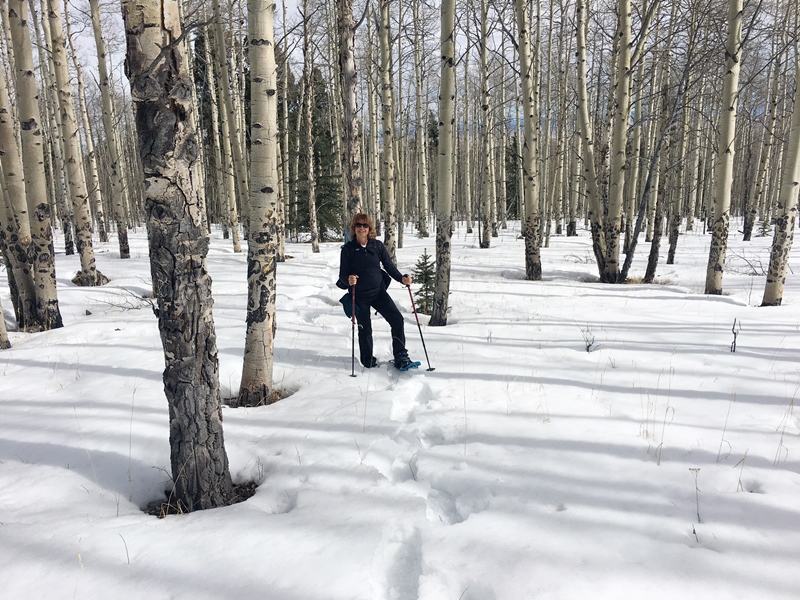
My blog posting about the next mountain to the south, Kaufman Ridge HP (W0C/SP-081), outlines a good way to access both summits during the summer. However, a seasonal gate closure (December to April) means we needed to find a different route. We approached the mountain from the north, parking our vehicle on Castle Court (a short side road off of Kaufman Road). We quickly crossed what appears to be private property (empty lot, no signs) to get to the US Forest Service boundary. Once we hopped the fence we were on public lands. We intentionally routed to the east to avoid some houses.
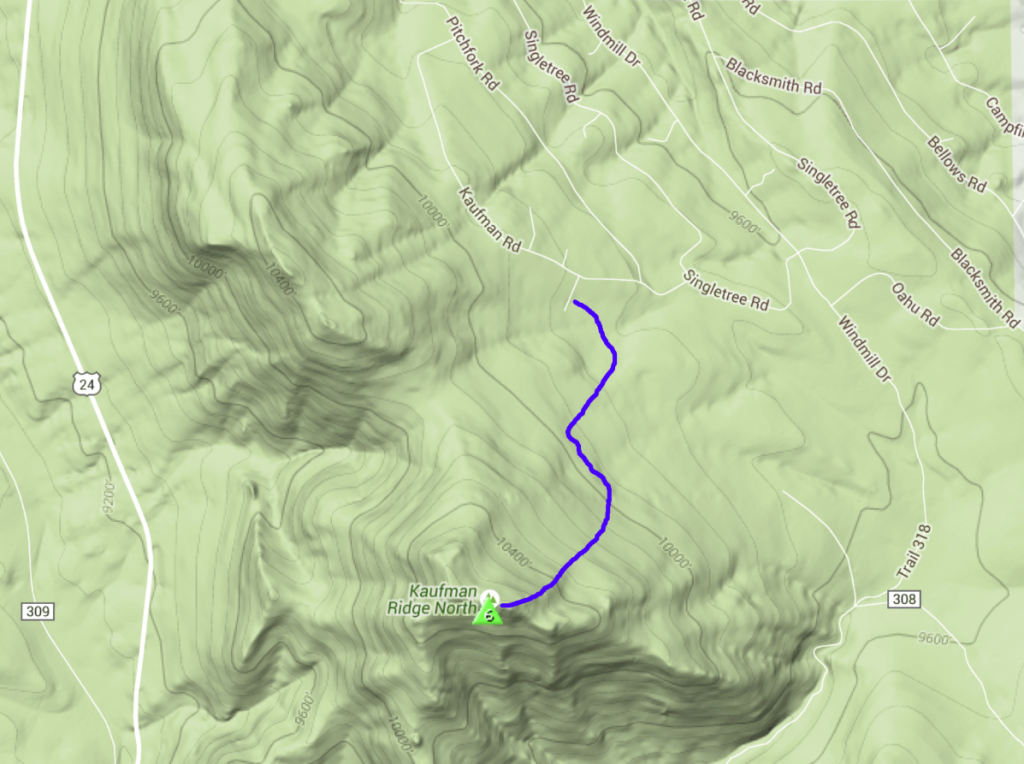
I don’t claim that this route is optimal. We had to break a lot of trail, pushing through the snow. We found a section of trail that had recent snowshoe traffic on it but it wasn’t of much use to us heading to the summit. We followed numerous game trails which appeared and disappeared on the side of the mountain. Mostly, we busted through the snow on our own. Surprisingly, the last quarter mile to the summit had little snow, so we removed our snowshoes at that point and just hiked in boots.
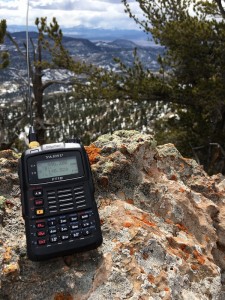 My Yaesu FT-1DR has become my favorite rig for SOTA activations. It covers both 2m and 70cm with dual-receiver capability. it has a built-in GPS receiver and APRS capability that facilitates easy APRS tracking. Joyce and I have a pair of these which we’ve been using to track each other’s positions on the few occasions we get separated on the trail.
My Yaesu FT-1DR has become my favorite rig for SOTA activations. It covers both 2m and 70cm with dual-receiver capability. it has a built-in GPS receiver and APRS capability that facilitates easy APRS tracking. Joyce and I have a pair of these which we’ve been using to track each other’s positions on the few occasions we get separated on the trail.
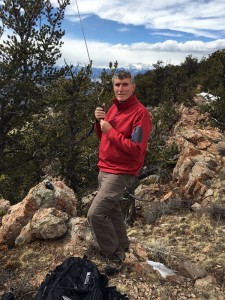
After we made the summit, I made a few contacts on 146.52 MHz. Thanks to Jim KDØMRC, Dave KØHTX, Carl K5UK and Candy KEØDMT for giving me my four required SOTA contacts.
The weather turned out to be better than predicted…partly cloudy and temps around 50 degrees F. On the way back down, we retraced our ascent path so we had more of a snowshoe trail to follow. I have to admit that this trip was a good lesson in how off-trail snowshoeing can really be a challenge. This was many times more difficult than a summer trail hike of equal length and elevation gain. Trip stats: 2.6 total miles, 1300 vertical feet.
At least, that’s my story and I’m sticking to it.
73, Bob K0NR
The post Winter SOTA Activation of Kaufman Ridge North appeared first on The KØNR Radio Site.
